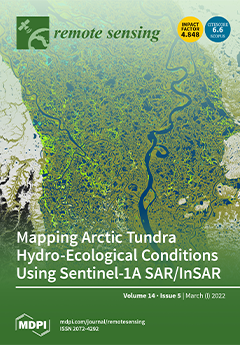Urban photochemical ozone (O
3) formation regimes (NO
x- and VOC-limited regimes) at nine megacities in East Asia were diagnosed based on near-surface O
3 columns from 900 to 700 hPa, nitrogen dioxide (NO
2), and formaldehyde (HCHO), which were
[...] Read more.
Urban photochemical ozone (O
3) formation regimes (NO
x- and VOC-limited regimes) at nine megacities in East Asia were diagnosed based on near-surface O
3 columns from 900 to 700 hPa, nitrogen dioxide (NO
2), and formaldehyde (HCHO), which were inferred from measurements by ozone-monitoring instruments (OMI) for 2014–2018. The nine megacities included Beijing, Tianjin, Hebei, Shandong, Shanghai, Seoul, Busan, Tokyo, and Osaka. The space-borne HCHO–to–NO
2 ratio (FNR) inferred from the OMI was applied to nine megacities and verified by a series of sensitivity tests of Weather Research and Forecasting model with Chemistry (WRF-Chem) simulations by halving the NO
x and VOC emissions. The results showed that the satellite-based FNRs ranged from 1.20 to 2.62 and the regimes over the nine megacities were identified as almost NO
x-saturated conditions, while the domain-averaged FNR in East Asia was >2. The results of WRF–Chem sensitivity modeling show that O
3 increased when the NO
x emissions reduced, whereas VOC emission reduction showed a significant decrease in O
3, confirming the characteristics of VOC-limited conditions in all of the nine megacities. When both NOx and VOC emissions were reduced, O
3 decreased in most cities, but increased in the three lowest-FNRs megacities, such as Shanghai, Seoul, and Tokyo, where weakened O
3 titration caused by NOx reduction had a larger enough effect to offset O
3 suppression induced by the decrease in VOCs. Our model results, therefore, indicated that the immediate VOC emission reduction is a key controlling factor to decrease megacity O
3 in East Asia, and also suggested that both VOC and NO
x reductions may not be of broad utility in O
3 abatement in megacities and should be considered judiciously in highly NO
x-saturated cities in East Asia.
Full article





